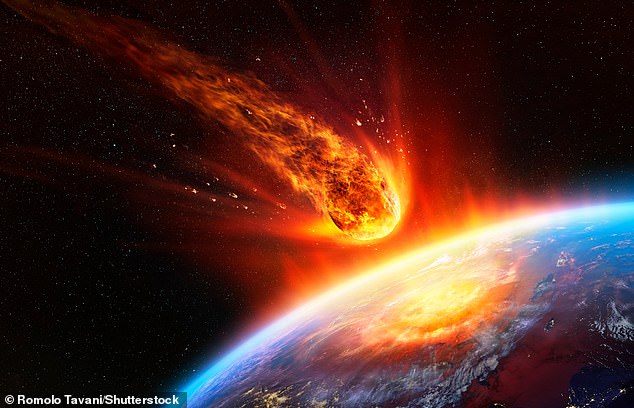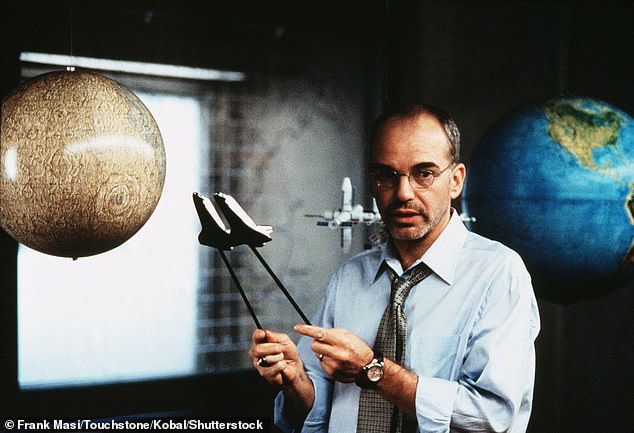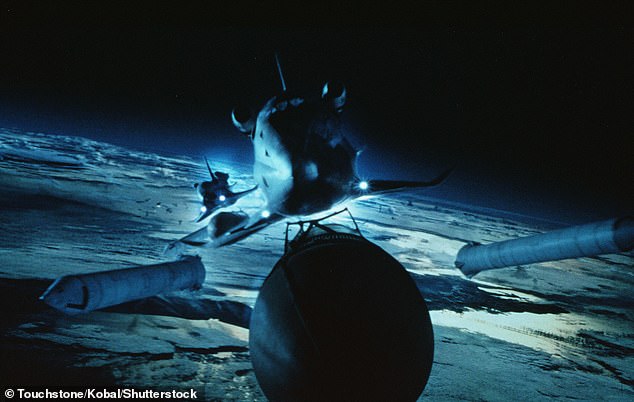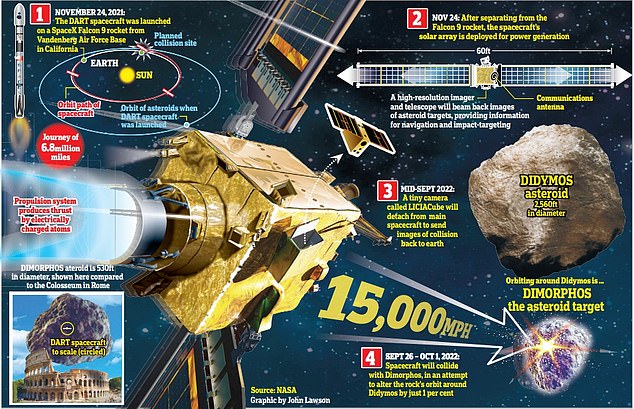Being wiped out by a massive space rock that hits Earth at thousands of miles an hour is one of the ways humanity could go extinct.
Worrying, a new report suggests we’re not prepared for such an eventuality – even if we detected the object 14 years in advance.
The official document, published by NASA and the US government, says asteroid disaster management plans ‘are not defined’.
There’s also ‘limited readiness’ to implement space missions that could lessen the dangers of an asteroid – like in the film ‘Armageddon’ with Bruce Willis and Ben Affleck.
In the 1998 blockbuster movie, NASA sends a group of drillers to blow up an Earth-bound asteroid and save humanity.

On average, Earth is hit by a football pitch-sized rock every 5,000 years, and a civilisation-ending asteroid every one million years, according to NASA’s Near-Earth Object Program

Billy Bob Thornton as Dan Truman, a a scientist at NASA, in Armageddon. Although a trope of sci-fi films, deflecting asteroids bound for Earth is a real concern
The report has been authored as part of the fifth ‘Planetary Defense Interagency Tabletop Exercise’, a simulation event held by NASA and the US government.
Although there are ‘no known significant asteroid impact threats’ for the foreseeable future, the biennial event assesses the ability of top experts to prepare for such an impact.
‘The process for making decisions about space missions in an asteroid threat scenario remains unclear,’ the report says.
‘The process has not been adequately defined in the US or internationally,’ it adds.
During the exercise, the experts considered potential national and global responses to a hypothetical scenario in which a never-before-detected asteroid had a 72 per cent chance of hitting Earth in approximately 14 years.

Representatives from NASA, FEMA, and the planetary defense community participate in the 5th Planetary Defense Interagency Tabletop Exercise to assess ability to respond effectively to the threat of a potentially hazardous space rock
As part of the hypothetical scenario, it was not possible to precisely determine the asteroid’s size, composition, and long-term trajectory.
But models indicated the asteroid could devastate a regional- to country-scale area, if it were to impact.
To complicate things, essential follow-up observations would have to be delayed for at least seven months – a critical loss of time – as the asteroid passed behind the sun as seen from Earth.
‘The uncertainties in these initial conditions for the exercise allowed participants to consider a particularly challenging set of circumstances,’ said Lindley Johnson, planetary defense officer emeritus NASA Headquarters in Washington.
‘A large asteroid impact is potentially the only natural disaster humanity has the technology to predict years in advance and take action to prevent.’
Unfortunately, the exercise found that ‘decision-making processes and risk tolerance’ are poorly understood among officials.
Worryingly, ‘asteroid impact disaster management plans are not defined’ and ‘timely global coordination’ to make people aware of such a space rock need more attention, the findings suggest.

In ‘Armageddon’ (1998), NASA sends a group of drillers to blow up an Earth-bound asteroid and save humanity
Of course, exercises like this are a vital part of preparing for the improbable event of an space rock impact similar to the one that wiped out the dinosaurs.
On average, Earth is hit by a football pitch-sized rock every 5,000 years, and a civilisation-ending asteroid every one million years, according to NASA’s Near-Earth Object Program.
Already, NASA has reached a hugely-important milestone with the DART asteroid deflection mission.
In September 2022, the DART spacecraft was intentionally crashed into Dimorphos, an asteroid 6.8 million miles away.
Although this asteroid posed no threat to Earth, the successful mission proved such a method could impact a space rock’s trajectory – if such an action was required.

NASA’s first ever ‘planetary defence’ spacecraft – sent to deflect an asteroid 6.8 million miles from Earth – hit its target on Monday, September 26
According to a 2017 study, only asteroids that span at least 18 meters (nearly 60 feet) in diameter are potentially lethal if they heading toward Earth.
The largest known asteroid in the whole of the Solar System, Ceres, is 580 miles in diameter (more than 3million feet) – big enough for humans to live on.
Thankfully the chances of Ceres hitting Earth are low because its orbit is further out, between Mars and Jupiter, and doesn’t intersect with Earth’s.
Unfortunately, there are some types of space rock that could prove difficult or impossible to deflect with any such manmade object, a study suggests.
‘Rubble pile’ asteroids – such as Itokawa around 1.2 million miles away – are made up of loose boulders and rocks that have clumped together under the influence of gravity, so much of them are empty space.
Such an asteroid would act as a ‘space cushion’ in that it would absorb any impact energy and carry on its trajectory, the study authors claimed.











